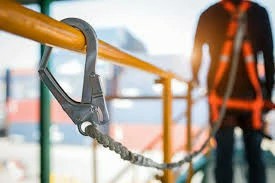Elevate Your Safety: The Integral Role of Effective Communication in Working at Heights
In high-risk work environments, especially when working at heights, effective communication is not just beneficial—it’s essential. Ensuring the safety of those working at elevated levels hinges on how well teams can communicate, coordinate, and respond to potential hazards. This blog explores the impact of clear instructions, teamwork, and emergency signaling in enhancing Working at Heights safety.
The Importance of Clear Instructions
When working at heights, clarity in communication can directly influence the safety and efficiency of tasks. Here’s how:
- Reduction of Misunderstandings: Clear verbal and non-verbal instructions minimize the risk of misinterpretation which can lead to accidents.
- Consistency: Utilizing standard terms and phrases throughout your team ensures everyone understands the same concepts and safety protocols.
- Pre-Task Briefings: Regular briefings help team members understand their roles and the hazards associated with their tasks.
Implementing Clear Communication Practices
To strengthen communication, consider the following strategies:
- Use Visual Aids: Employ diagrams and labels on equipment to provide visual guidance.
- Standard Operating Procedures: Develop SOPs that outline the exact communication required for different tasks.
- Feedback Mechanisms: Encourage team members to ask questions and provide feedback to ensure comprehension.
Teamwork as a Pillar of Safety
Teamwork is the backbone of any safe work environment, particularly in high-risk situations. Collaborative efforts enhance safety through:
- Shared Responsibility: When team members work closely, they feel a collective responsibility for each other’s safety.
- Increased Vigilance: Teamwork fosters an environment where members can keep an eye on one another, identifying potential hazards and correcting unsafe practices.
- Effective Problem Solving: Collaborative discussions encourage effective problem-solving, allowing teams to identify and mitigate risks swiftly.
Fostering Effective Team Collaboration
To promote teamwork in Working at Heights safety:
- Team Building Exercises: Engage in regular team-building activities to strengthen relationships and communication skills.
- Role Assignments: Clearly designate roles and responsibilities for all team members involved in height work.
- Regular Safety Meetings: Hold frequent safety meetings to discuss challenges and share solutions experienced by the team.
The Role of Emergency Signaling
Despite thorough planning, emergencies can occur. Effective communication during these situations is vital to ensure swift action is taken:
- Standardized Signals: Utilize standardized hand signals or radio calls to communicate in noisy environments where verbal instructions may be inaudible.
- Emergency Protocols: Clearly define emergency protocols in advance, ensuring every team member knows their role in an emergency.
- Regular Drills: Conduct emergency drills regularly to prepare teams for swift and coordinated responses.
Best Practices for Emergency Communication
When implementing emergency communication strategies, consider:
- Clear Visual Indicators: Use lights, flags, or other visual aids to signal emergencies.
- Radio Communication Systems: Equip team members with radios for immediate communication during emergencies.
- Documentation: Maintain records of all communication protocols and procedures for reference and training purposes.
Investing in Working at Heights Training
To maximize safety while working at heights, investing in comprehensive Working at Heights Training is crucial. This training will not only cover safety protocols but will also emphasize the importance of effective communication among teams. Consider enrolling in a Working at Heights Course Online or a Working at Heights Safety Course designed to equip workers with necessary skills and knowledge.
Conclusion: Elevating Safety Through Communication
Effective communication is a critical factor in ensuring safety for those working at heights. By implementing clear instructions, fostering teamwork, and establishing robust emergency signaling practices, companies can significantly reduce the risk of accidents. Investing in a comprehensive Working at Heights Certification program is one of the best steps you can take towards achieving a safer work environment. For inquiries, feel free to reach out at [email protected].



 349,500 Offered Certificates
349,500 Offered Certificates
 24/7 Online Training
24/7 Online Training
 Money Back Guarantee
Money Back Guarantee
 Fully Accredited Courses
Fully Accredited Courses
